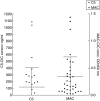Presence of plasma complement regulatory proteins clusterin (Apo J) and vitronectin (S40) on circulating immune complexes (CIC)
- PMID: 16907906
- PMCID: PMC1809708
- DOI: 10.1111/j.1365-2249.2006.03135.x
Presence of plasma complement regulatory proteins clusterin (Apo J) and vitronectin (S40) on circulating immune complexes (CIC)
Abstract
The complement regulatory (CR) proteins clusterin and vitronectin bind to the membrane attack complex (MAC) and thus prevent cytolysis. In this report, we demonstrate the presence of both of these CR proteins on MAC bound to circulating immune complexes (CIC). We measured the amount of clusterin and vitronectin on MAC in plasma, also referred to as soluble MAC (SMAC), as well as on MAC bound to CIC (MAC-CIC), using antibody directed to polymerized C9 in systemic lupus erythematosus (SLE) patients. We observed a strong correlation among the quantities of SMAC and MAC-CIC. The amount of both clusterin and vitronectin associated with MAC-CIC was two- to threefold higher in comparison to the SMAC. Patients with high levels of clusterin and vitronectin demonstrated renal involvement. We hypothesize that these complement regulatory proteins besides regulating the insertion of MAC play other critical roles, in disease pathogenesis.
Figures





Similar articles
-
Determination of circulating immune complexes, C3 and C4 complement components and anti-DNA antibody in different classes of lupus nephritis.Int J Pediatr Nephrol. 1984 Jun;5(2):75-82. Int J Pediatr Nephrol. 1984. PMID: 6333404
-
Complement-mediated solubilization of immune complexes in systemic lupus erythematosus.Clin Exp Immunol. 1982 Apr;48(1):37-42. Clin Exp Immunol. 1982. PMID: 6979449 Free PMC article.
-
Cloning of the sixth complement component and, spatial and temporal expression profile of MAC structural and regulatory genes in chicken.Dev Comp Immunol. 2010 May;34(5):485-90. doi: 10.1016/j.dci.2010.01.003. Epub 2010 Jan 17. Dev Comp Immunol. 2010. PMID: 20067805
-
Soluble Membrane Attack Complex: Biochemistry and Immunobiology.Front Immunol. 2020 Nov 10;11:585108. doi: 10.3389/fimmu.2020.585108. eCollection 2020. Front Immunol. 2020. PMID: 33240274 Free PMC article. Review.
-
How Structures of Complement Complexes Guide Therapeutic Design.Subcell Biochem. 2021;96:273-295. doi: 10.1007/978-3-030-58971-4_7. Subcell Biochem. 2021. PMID: 33252733 Review.
Cited by
-
Pain-associated biomarkers in breast cancer.J Med Life. 2015 Jan-Mar;8(1):32-6. J Med Life. 2015. PMID: 25914735 Free PMC article.
-
Complement Properdin Determines Disease Activity in MRL/lpr Mice.Medicina (Kaunas). 2020 Aug 27;56(9):430. doi: 10.3390/medicina56090430. Medicina (Kaunas). 2020. PMID: 32867176 Free PMC article.
-
Clusterin is a Potential Therapeutic Target in Alzheimer's Disease.Mol Neurobiol. 2024 Jul;61(7):3836-3850. doi: 10.1007/s12035-023-03801-1. Epub 2023 Nov 29. Mol Neurobiol. 2024. PMID: 38017342 Review.
-
The Emerging Roles of Extracellular Chaperones in Complement Regulation.Cells. 2022 Dec 2;11(23):3907. doi: 10.3390/cells11233907. Cells. 2022. PMID: 36497163 Free PMC article. Review.
-
Reduced order modeling and analysis of the human complement system.PLoS One. 2017 Nov 20;12(11):e0187373. doi: 10.1371/journal.pone.0187373. eCollection 2017. PLoS One. 2017. PMID: 29155837 Free PMC article.
References
-
- Rother RP, Mojcik CF, McCroskery EW. Inhibition of terminal complement. a novel therapeutic approach for the treatment of systemic lupus erythematosus. Lupus. 2004;13:328–34. - PubMed
-
- Chiu YY, Nisihara RM, Wurzner R, Kirschfink M, Messias-Reason IJ. SC5b-9 is the most sensitive marker in assessing disease activity in Brazilian SLE patients. J Invest Allergol Clin Immunol. 1998;8:239–44. - PubMed
-
- Fishelson Z, Attali G, Mevorach D. Complement and apoptosis. Mol Immunol. 2001;38:207–19. - PubMed
-
- Bohana-Kashtan O, Ziporen L, Donin N, Kraus S, Fishelson Z. Cell signals transduced by complement. Mol Immunol. 2004;41:583–97. - PubMed
-
- Choi NH, Nakano Y, Tobe T, Mazda T, Tomita M. Incorporation of SP-40,40 into the soluble membrane attack complex (SMAC, SC5b−9) of complement. Int Immunol. 1990;2:413–7. - PubMed
Publication types
MeSH terms
Substances
LinkOut - more resources
Full Text Sources
Medical
Research Materials
Miscellaneous

